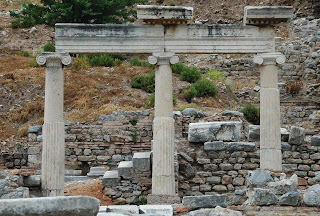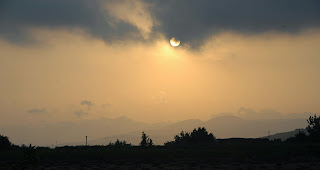Today we visited three sites in Selçuk (Ephesus), two historical and one current. First, the Pilgrim Church of St John and Ayasuluk Castle, then the Ancient City of Ephesus, and on the way to that, the Yüksel Carpet school, where women are trained to make Turkish carpets, which they can then produce as a cottage industry, selling their carpets through Yüksel Carpets.
First, the church. To sum it up, here is a paraphrase of the sign on a model of the basilica before it fell into ruin:
The Great Basilica, known as the Justinian Basilica, was built in the sixth century to honour the burial place of the Apostle St. John who came to Ephesus in company with the Virgin Mary after the death of Christ. Its main aisle was crowned with six huge 95-foot-high cupolas. If fully restored it would be the seventh largest cathedral in the world. St. John was held in such esteem that the cathedral might have been even larger were it not for the limitations of the site.
The Emperor Justinian and his wife Theodora made large financial contributions and her name was inscribed above the big capitals crowning the beautiful marble columns. An inscription carved over the tomb read "This is my resting place forever, here will I remain". Legend has it that when the tomb was opened in later centuries, it was found only to contain dust which quickly wafted away in the breeze.
The Emperor Justinian and his wife Theodora made large financial contributions and her name was inscribed above the big capitals crowning the beautiful marble columns. An inscription carved over the tomb read "This is my resting place forever, here will I remain". Legend has it that when the tomb was opened in later centuries, it was found only to contain dust which quickly wafted away in the breeze.
This is a huge site. We got there early — later on, the crowds were beginning to assemble! We wandered the place, noting a couple of interesting points. First, the tomb of St. John the Evangelist takes pride of place in the nave of the basilica, and second, in the baptistery there is evidence of the ritual of baptism carried out here — there is a small pool in the centre, with steps down into it from two sides. Presumably the baptist and person undergoing baptism approached and met each other in the pool. Either this, or for a mass baptism, there could have been a procession of people entering the pool at one end and leaving it at the other. Whatever the case, there was only room in the pool for one baptism at a time.
On the hill behind the Church of St. John is the Citadel, built in the 6th century AD. The walls and towers have recently been restored, and only in 2013 was the inner castle made accessible to visitors.
In the inner castle are the remains of houses, the castle Mosque (which is currently undergoing restoration), the castle villa and bath, and a rocky platform at the top of the hill. This platform is most interesting. There is a cistern there, dated to the Turkish period, but it is actually the eastern (apse) section of a Byzantine basilica built here to commemorate St. John, who is believed to have written his gospel and prayed here when he was an old man of ninety.

Looks weird! This capital was lying on the ground.
We've inverted the picture so you can see it
roughly as it was when in place
Then we set off for the ancient city, a short drive away. We got to the car park and were ushered into an area set aside for campers — we noticed that David and Carol were there ahead of us (but we never caught up with them!). In the parking lot was a shuttle service that took you to the top of the old city — the route down is the way to go through it — but which first takes you to a Carpet School, where you are given royal treatment, told all about carpet making, shown examples of carpets (they hope you might buy, but there is no compulsion). The sign over the door says "T.C.M.E.B. Selçuk Halk Eğitim Merkezi Müdürlüğü — Turkish Board of Education Weaving Course", and this place supplies many of the major outlets of Turkish carpets.
Proper Turkish carpets use a double knot (whereas Persian and other carpets have a single knot). And the way the nap sits, if you turn the carpet through 180°, the colours look very different. Turkish carpets are wool on wool, wool on cotton, cotton on cotton, and silk. They demonstrated the taking of the silk from the silkworm cocoons, and we were shown a carpet (of Da Vinci's Last Supper) being made. It is a long and tedious process, so it is no wonder that these carpets are so prized. We were taken into the 'Treasure Room', where their finest carpets are kept — some silk ones were 2000 knots to the square inch, incredibly fine. Some of the carpets were only about 18"×12", and worth over €20,000. Wow! A bit out of our budget!
From here, we were driven up to the top entrance to the ancient city of Ephesus. This is a huge site, and was already very busy with tourists.
One of the first spots along the way looked like a Roman theatre, but was in fact the Odeon, or Bouluterion, the meeting place for the city's senators — let's face it, orators and politicians need the same kind of stage as actors (and are often just as believable). But it did also function as a concert hall.
As you turn the corner into Curetes Street, the part of the ancient the Sacred Way between Domitian Square and the Celsius Library, you meet a relief of Nike. Curetes Street was busy in ancient times, and was busy today! In this street, the Temple of Hadrian still has much of its four-columned portico intact, with its arch and its pediment with acanthus leaves and a bust of a woman, possibly a Medusa. The friezes to each side of the door are reproductions, the originals being safely housed in the Ephesus Museum, which we visit tomorrow.
There was a wonderful mosaic in the pavement beside the road. And then we came to the terrace houses on the uphill side of Curetes Street. These have recently been roofed to protect them, and beneath this roof a huge conservation and restoration effort is taking place. This is the ideal place for a jigsaw fanatic to seek employment — there is table after table of fresco fragments waiting to be reassembled into some kind of order and restored to the walls they came from. The only problem is that you would need a degree in archaeology as well. In the terrace houses, there are numerous wall frescoes intact and in place, and also floor mosaics, some of which are truly magnificent!
Leaving the terrace houses, we came down to the Library of Celsius, This must have been a superb building in its time, but today virtually only the facade is in place, and this only due to a monumental effort at reconstruction. The path in front of library leads you into the main Agora, or town square, which served as a meeting place, a market, and served virtually all of the day-to-day goings on of a busy city. Beyond the Agora, on the other side of the road, is the Great Theatre, which seated nearly 24,000, the largest theatre in Asia Minor. It is imposing today, and must have been even more impressive in its day. A road leads straight up to it from what used to be the harbour, and this road was one of the few in ancient times to have street lighting — it must have been a magnificent entry into the city from the harbour!
Leaving the city itself, you come to the Church of Haghia Maria (The Church of the Virgin Mary), the ruin of a basilica built in honour of the Virgin Mary, who spent her latter days in Ephesus. It was here that the first Ecumenical Council was held in 431 AD.
We finally left the ancient city, passing more tourist traps, including one that amused us greatly — 'Genuine Fake Watches' — are we all that gullible? We also passed a stand of horse-drawn phaetons, which many tourists like to take up to the top of the site before they make the long walk down.
From here, we adjourned to the local campsite, Garden Camping, which was a secluded spot immediately below the citadel, for a pleasantly quiet night.
Distance driven — today, 32 miles ( 52 km ); to date, 20,580 miles ( 33,121 km )









































































Makes you feel there might be something right about the stories and possible myths of Christianity and before then doesn't it? Personally I don't think one is very much honoured by ruins. however their attempts at restoration are great. Love Cathy
ReplyDeleteThis was a huge day for us. This is Susie speaking. I am amazed to be seeing history that takes us back to early Christianity..For me this just makes it all more feasible and true. Finding an area where early baptisims took place WOW I was baptised in this way. And then a church where the Virgin Mary was....better than Dan Brown
ReplyDelete